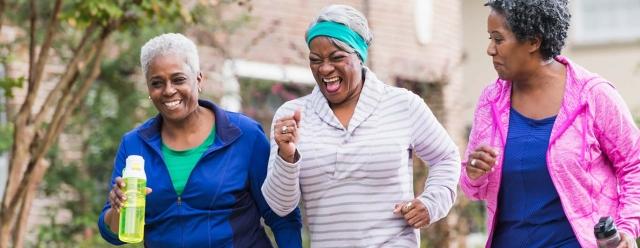The Case for Staying Active
Why It Matters
- Physical activity can help make the body function better and boost your health.
- Getting active is one of Life’s Simple 7 — key measures that can do the most to improve cardiovascular and overall health.
- Investing in your health may save money in the long run by reducing medical costs.
Staying active is one of the most important things you can do to prevent heart disease and improve your overall health and well-being.
It can help you lose weight, preserve your health as you grow older, or recover after a cardiac episode or procedure. Physical activity takes many forms and can be achieved at all ages.
“It is the best medicine,” said Dr. Randal Thomas, M.D., medical director of the cardiac rehabilitation program at the Mayo Clinic in Rochester, Minnesota. “The more active we are, the better our bodies are functioning.”
That includes improving cardiovascular health, strengthening bones and muscles, and even reducing the risk of certain cancers. Recent studies also suggest physical activity benefits white and gray matter in the brain, which leads to enhancement of cognitive processes like thinking and memory, attention span, and perception.1
Check out these videos to discover simple ways to boost your workouts.
Getting moving
Physical activity doesn’t require a gym membership or expensive exercise equipment and gear. “It can be very low cost,” Thomas said.
Dancing, walking in your neighborhood, raking leaves, or taking the stairs at work instead of the elevator are all ways to get moving. “If you’ve been living a sedentary life, start with an activity you enjoy and keep your initial exercise session short,” Thomas said.
“Get up off the couch and do something at least five minutes a day,” he said, suggesting that five minutes be added each day to build up gradually to a sustained period of movement.
The American Heart Association recommends adults get at least 150 minutes per week of moderate intensity aerobic activity or 75 minutes of vigorous intensity aerobic activity. Even short bursts of activity are helpful, and almost any physical activity is better than none, including yoga, strength training — and even gardening.2
“We can feel these effects pretty quickly,” Thomas said.
Endurance exercise, or aerobic activity, should be included along with strength, balance, and flexibility exercises as part of a healthy workout plan.3
If physical activity already is part of your routine, remain mindful of sitting for too many hours at a time.
“Extended sedentary time can be harmful and cause you to lose the benefits of exercise,” Thomas added. It can increase the risk of heart disease, stroke, and diabetes.4
Exercise, age, and rehab
For those living with heart disease, including people who’ve had a recent heart attack or heart procedure, physical activity boosts recovery and may help avert issues later.
“We get people moving, literally, while they’re still in the hospital,” Thomas said. “The goal is to get a heart patient into a cardiac rehabilitation program within the first week of leaving the hospital.”
Cardiac rehab offers supervised exercise and includes nutrition counseling, smoking cessation assistance, and emotional support. It can help reduce the risk of death from heart disease and reduce the risk of future heart problems.
“Patients should not fear exercise,” Thomas said. “Though some easing into exercise is necessary at the beginning, cardiac rehab patients can and should be physically active.”
Many health insurance plans cover cardiac rehab. Patients should work with their healthcare provider to get a referral and find out about co-payments under their health plan.
With all physical activity, people who have medical concerns should seek guidance from their physician first. Older people, for example, may want to pay special attention to balance, but they can remain active through supported seated aerobics, stationary bikes, or treadmills that have side rail handles.
In fact, the latest federal physical activity guidelines recommend older adults mix balance training with muscle-strengthening and aerobic activities.5
Children need exercise, too. Youngsters between 6 and 17 years old should get an hour or more of moderate to vigorous physical activity each day.6
Try to ensure physical activity is part of play for younger children and consider organizing an active family event.
Saving money
Physical activity can boost your pocketbook as well as your body. By staying healthy, you avoid costly expenses related to medical needs, according to the CDC.7
In an effort to help prevent cardiovascular disease, the American Heart Association has developed Life’s Simple 7, easy-to-implement measures that can make a big difference in your overall health. Physical activity is one of the steps. The other six are eating a healthy diet, managing blood pressure, controlling cholesterol, reducing blood sugar, losing weight, and quitting smoking.
It’s never too late to get moving, even in your 50s, 60s, and beyond. Getting physically active in middle age and later can make for a brighter future.
Things to Consider:
- Start with five minutes of a physical activity you enjoy, then add another five minutes daily as you build up to 150 minutes per week.
- Organized exercise isn’t the only way to be physically active; consider dancing, walking, or bicycling to get moving.
- If you have a medical condition or other concerns, seek guidance from your healthcare provider before beginning physical activity.
1 “Working Out Boosts Brain Health,” American Psychological Association, March 2020
2 "What Exercise Is Right for Me?" American Heart Association, accessed January 2022
3 "Four Types of Exercise Can Improve Your Health and Physical Ability," National Institute on Aging, January 2021
4 “Heart Disease and Stroke,” CDC, January 2022
5 "Best Exercises for Every Age and Gender," MDLinx, May 2020
6 "How Much Physical Activity Do Children Need?" CDC, May 2021
7 "Health and Economic Costs of Chronic Diseases," CDC, January 2022
Transamerica Resources, Inc. is an Aegon company and is affiliated with various companies which include, but are not limited to, insurance companies and broker dealers. Transamerica Resources, Inc. does not offer insurance products or securities. The information provided is for educational purposes only and should not be construed as insurance, securities, ERISA, tax, investment, legal, medical or financial advice or guidance. Please consult your personal independent professionals for answers to your specific questions.



